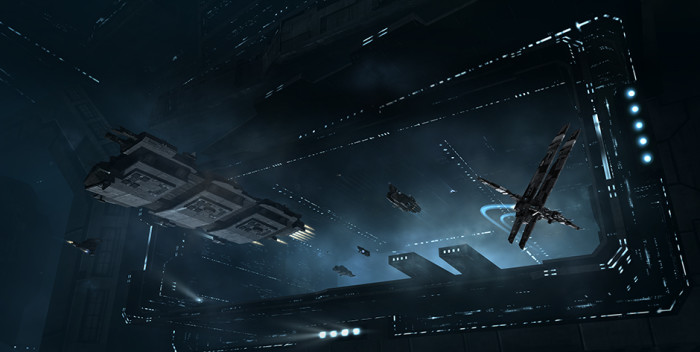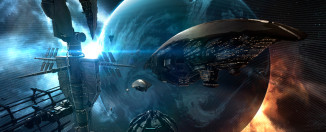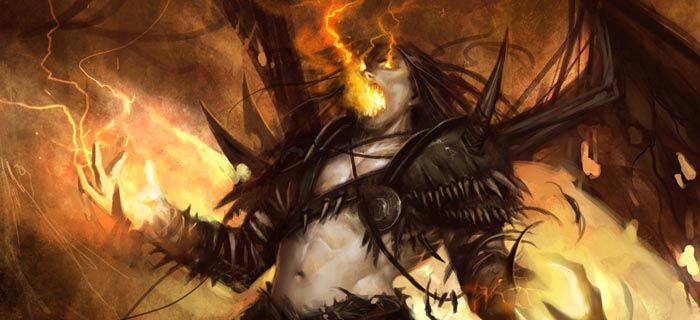EVE Online Exploration Guide: Core/Combat Probe Scanning
Don’t miss out! This is just one chapter of our full EVE Online Exploration guide.
After you’ve launched your probes and begun warping off to a safe point (mind you players can scan with probes while mid-warp or cloaked, or both), it’s time to choose what to scan. If there’s only one cosmic signature in the system, feel free to skip ahead. But don’t make the mistake assuming all signatures are created equal.
When choosing where to start, understand that the larger a signature is, the more valuable it tends to be. This applied unilaterally to data, relic, gas, and combat sites (not sure about wormholes) and the reasoning is pretty simple: large signatures are less precisely defined, and thus harder to scan down. A site that began as a tiny dot fitting within a 0.50 AU spread would be a joke to scan down, and would therefore not be as rewarding as something that required eight or nine tiers of pinpointing.
This also leads to the slightly unintuitive the hierarchy of signature representation. All signatures begin as three-dimensional bubbles with size proportionate (indirectly) to their signature strength and (directly) to their general value. These bubbles indicate the site could be anywhere within their sphere, which is obviously a relatively huge expanse of space.
Signatures that’ve been narrowed down slightly within a smaller radius will appear as two-dimensional rings. At this point, your probes are telling you the site is somewhere along the edge of the ring, now 360 degrees across a flat plane. In general, if you follow my advice, you’ll never end up with rings anyway.
Two red dots indicate your probes have narrowed the site down to exactly two possible locations. In this instance, you will need to center and expand your pinpoint formation to cover both dots, hopefully eliminating one. As a pro tip, keep in mind signatures tend to be close to celestial bodies, so if you see one dot near a planet and another 10 AU away from everything in the solar system, put your ISK on the less adventurous of the two.
Finally, accurate three dimensional readings will give you a zero-dimensional red dot or yellow marker that indicates the approximate location of site in space. At this point, you will only require fine tuning at smaller radii in order to amplify the signal strength to a warp-able level.
Let’s Get Down to Business
To actually begin scanning signatures, launch your core probes in a pinpoint formation. Core probes should always be used for signature scanning because combat probes have a minimum scan accuracy of 0.50 AU, so half that of core probes at 0.25 AU. And while spread formation has its uses in combat scanning (more on that later), you will never need it for signatures since they’re already pre-highlighted on your solar system map.
You can remove distractions by highlighting signature names in the probe scan window, including CTRL-selecting or SHIFT-selecting multiple entries. Only the chosen sites will remain visible, making it easier to concentrate on your intended target. And while you can try to scan more than one site at a time, you’ll generally fail at all but the widest ranges, so don’t waste your time.
Now the key to scanning quickly and efficiently with as few fuckups as possible, and the one thing most people who suck at scanning don’t understand, is that you should focus on probing in two dimensions at a time. Since the process is inherently three dimensional, a lot of players just jump in, start zooming around and dragging their probes all over the place, only to realize they’re now twenty million kilometers too high, or three lightyears too far to the left.
This is a larger waste of time than asking out the popular kid your in class (they’re out of your league), so take this more manageable approach. This is so incredibly simple you’ll thank me if you’ve been doing it any other way. Feel free to send a billion ISK to Chance Ravinne.
Step 1: Level out the camera so you are looking at everything (the signature, your probe cluster) at “ground level.” In other words, you can’t see the “top” or “bottom” of the probe control box, only the sides. Grab the up or down arrow (not the middle or sides of the box) and align it to the vertical center of the signature. You are now 50% perfectly aligned. Give yourself a pat on the back.
Step 2: Turn the camera so you are on “top” of your probes. Zoom out if you need to (and note that you can double-click the probe box to center the camera). Grab the “top” face of the box (the only square you should be able to see – make sure you’re clicking the box face and not the “up” arrow), and align it to the horizontal center of the signature. Wouldn’t you know it, it’s like 90% aligned now!
Step 3: Zoom in and repeat steps 1 and 2 once each. The farther zoomed in you are, the more accurate your scan will be and the less likely you’ll end up with the dreaded RROD (red ring of deviation).
Step 4: Expand your probe radiusso thatthe entire signature is at least covered by your centermost scan sphere. This step is only necessary while your signature is still a sphere, a ring, or two dots.
Step 5: Hit scan. You could certainly twiddle your thumbs here, but I prefer to do things like realign my camera or check local/d-scan for miscreants.
As you may or may not have noticed, this was really friggin’ easy. By focusing on height and width completely separately, you can get your probes centered in two or three seconds instead of minutes of guesswork. You’re welcome.
Pinpointing Your Rangefinding Acquisition
Once your initial scan is complete, you will now have to narrow down what’s left. There are a few possible results based on how well you performed the first probing.
There is still a sphere: Somehow, you totally messed up. Realign your probes and try again.
There is a ring or two dots: Your initial probe sphere was too tight. Make sure you’re covering every area of the sphere/ring/both dots with your center sphere and try again.
There is one dot, and it’s far from your probe cube: You did a good job scanning on round one, but the signature’s scan deviation happens to be very high. This means that the perceived center of the signature and its actual center vary greatly. Recenter your probes directly over the signal, taking extra care to zoom in a bit for greater accuracy. Drop your scan radius down one factor (from 8 AU to 4 AU, or from 2 AU to 1 AU) and re-scan. Most likely the result will be just as annoying, so be prepared to make slow and steady progress.
There is one dot, and it’s close to your probe cube: Your initial scan attempt was very good, and you’re lucky enough that this signature has a low scan deviation. Zoom in a bit, recenter your probe mass, and drop your signature radius by two factors (e.g. from 16 AU to 4 AU, or from 4 AU to 1 AU). In all likelihood, the resulting signature will still be within even this tiny area, saving you a lot of time and energy.
There is a yellow marker: At this point, you are extremely close to pinpointing the signature’s exact location. You can proceed to narrow your signature radius and recenter the probe mass as you would in most scenarios, but you will be limited by your inherent scan strength (skills, ship bonus, fit, etc.) and your probes’ 0.25 AU minimum radius.
Zoom and Enhance
Even zoomed in all the way with probes exactly centered on the target in all three dimensions, you may find yourself stuck at 90%-95% signature strength.
This is where your custom probe formation comes in. Useless in almost every other situation, the custom probe formation (the rightmost option after spread and pinpoint formations) is a user-defined 3D layout, and it’s the only way to sniff out the most irksome signatures.
With your probes launched in a 0.25 AU pinpoint formation, zoom in all the way and hold the shift button. You will see now that you can move individual probes as long as shift is depressed. One at a time, pull each outlying probe inwards about halfway, so that it overlaps the center sphere a lot more. You only really have to do this in one dimension; pull the “rightmost” sphere a little to the left, nudge the “leftmost” sphere to the right, and tug the top and bottom probes down and up, respectively. The end result will look much more like one tight sphere with fuzzy edges all around.
Click the menu button next to the custom formation icon and save this formation. It will be hugely valuable when pinpointing hard-to-scan targets. It works equally well in combat scanning, though this formation is terribad for initial scans. Only use it as a last resort when your normal 0.25 AU pinpoint spread is failing you.
If you still can’t get a 100% signature strength even with a custom formation, odds are your scan strength simply isn’t good enough. Consider upgrading your astrometrics, astrometric rangefinding, or racial skills, getting a gravity rig or rangefinding array, Sisters launcher or probes, or a rangefinding implant. It’s also possible you’re just not very good at scanning, so practice your 3D centering skills using the method outlined in this chapter.
Only You Can Combat Scanning Guide
From a purely mechanical point of view, combat scanning is identical to core scanning. Yes, you will need an expanded probe launcher equipped with combat scanning probes… but all the probe placement, zooming, alignment, and indicators are basically the same. In fact, combat probing is easier, since all but the tiniest targets have significantly stronger signals than do cosmic signatures.
Most of the time, combat scanning will be a secondary activity. Since combat probes aren’t as accurate as core probes, you should only load them when you’re actually prepared to follow through. Here are some situations you might want to bust out the blue ammo:
- There are possibly hostile players in system and your intended jump is outside of d-scan range
- There are possibly stupid players in system and you want to find and kill them
- There are drones, probes, or deployable structures on d-scan that you want to steal/loot
- There is an abandoned ship on d-scan that you want to steal/salvage/killmail whore
- There are mission runners in system, and you want to ninja salvage their NPC wrecks
(Note you cannot scan wrecks, so if you want to ninja salvage you must lock onto either the player running the mission, or a mobile tractor unit that’s been placed to collect the goodies.)
Unlike with cosmic signatures, ships and deployables don’t appear on the solar system map automatically. You will have to launch your combat probes in either spread formation over the whole region or pinpoint formation in an area you already suspect houses your prize.
This is where d-scan can be of immense value, since you can specifically search the space 1, 2, 4, 8, or just under 16 AU around you, then adjust probe scan radius to match. If you see a mobile tractor unit within 6.5 AU of your ship on d-scan, you can center your probes at your exact location, then scan at 8 AU out with certainty your target is somewhere in range.
For the most part, the structures setting should be avoided unless you are specifically looking for a mobile depot or tractor unit. Since most player-owned stations (which are structures) are comprised of many, many, many buildings, they can quickly litter your scan results list. For obvious reasons, you should also avoid the catch-all setting that displays every possible scan type. Just stick to ships and drones/probes, tuning into structures only temporarily.
No matter how you intend to use combat probes, it’s important to remember that they are visible to everyone on d-scan and instantly convey animosity to other players. You might be launching probes out of fear, but other capsuleers may take your premature exploration as a sign of aggression. Always remember that the second you launch blue probes, you are sending a message: “I’m going to find you.”
When you’re done with combat scanning, make sure you switch your scanning filter back to “show everything” or “cosmic signatures.” I’ve forgotten this many times and have wandered through tons of star systems wondering “Why aren’t there any damn signatures?” It was only after many minutes I realized I still had my scanner set to structures, meaning I had probably missed out on dozens of data and relic sites. Don’t let this happen to you.
Some Final Tips About Wasting Time
Scanning is an inherently time-consuming and potentially boring activity, so maximizing your efficiency and making good use of the in-between moments is always in the interest of explorers like you. Here are some additional tips on what to do while you wait for your probes to finish um, probing.
- Snoop around the system with d-scan to look for juicy theft/salvage opportunities
- Warp to celestials near your current signature target to save on later warp time
- Send a few ISK to that nice Chance Ravinne guy who wrote up that exploration guide
- Fly around the solar system and create bookmarks at various safe spots for later
- Reload your launcher (you’ll have to be decloaked) to save time in the next system
- Check market values for your cargo loot and jettison unwanted garbage
- Switch to the star map and refine your intended exploration route
- Just appreciate the scenery. Why can’t kids just appreciate nature anymore?
Try EVE Online Free for 1 Month
Interested in checking out the EVE universe for yourself? Click here to activate a 30-day trial!







[…] Core & Combat Probe Scanning […]
I think a video would be great here. While I think I understand your method, as a complete newb to exploring, a video would do wonders to know exactly what you’re talking about and matching the terminology.
It was hard to find your website in google.
I found it on 22 position, you have to build some quality backlinks , it will help you to get more visitors.
I know how to help you, just search in google – k2
seo tricks
Right here is the right web site for anybody who hopes to understand
this topic. You understand so much its almost tough to argue with you (not that I really
will need to…HaHa). You definitely put a brand
new spin on a topic that’s been written about for many years.
Wonderful stuff, just excellent!
Your guide is what I´ve been looking for, thanks. And about “focus on probing in two dimensions at a time”, yeah i wasted like 1 hour yesterday until i realized your 1,2,3 steps system by myself, your guide is great.
When you press Shift, all probes show up and you can move them around one by one.
But when you press SHIFT+ALT you can move all “outer” probes at once.
Few more quick tips for those how have bit higher skills then fair:
* Signatures are allways within 8 AU from planets, so on first scan always use 8 AU radius and center probes to closest planet (16+ AU are used just for combat scanning)
* If U get 2 dots – farest one from your current probe center will always be the right one
* If U get nice dot (not ring) after first scan (8 AU) – u can narrow radius to 2 AU